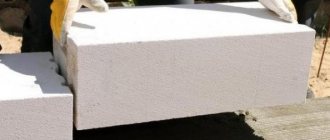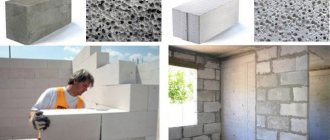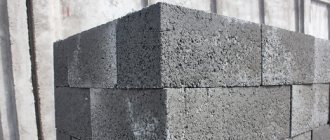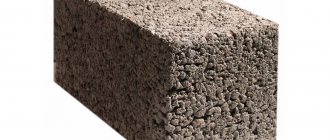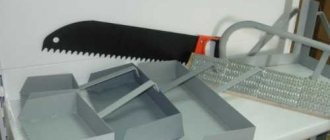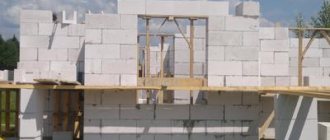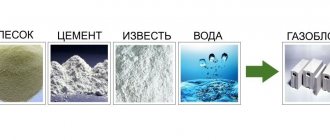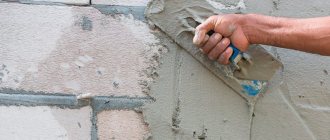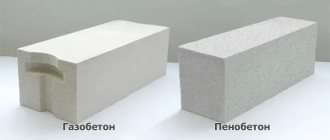The load-bearing capacity of an individual aerated block and the finished wall are very different, and therefore, when designing a building, you need to know how to determine the load-bearing capacity of a section of the wall. In this review we will talk about the strength of the blocks, classes, and other points related to the design characteristics of the walls.
Let's start with the fact that autoclaved aerated concrete comes in different densities, from D300 to D700. The higher the density of the blocks, the stronger they are, often. Moreover, at different factories with the same density, the strength class may differ. For example, at one plant, aerated concrete D400 has a class B3.5, and at the second, D400 already has a class B2.
Technical characteristics of gas blocks
Aerated concrete has been used in low-rise construction in different countries for more than 80 years.
During this time, it has established itself as a reliable and convenient material with excellent technical characteristics. Its porosity reaches 85% of the total volume. At the same time, it is quite durable. Experts say that gas blocks have the porosity of wood and the strength of stone. The gas block has the following characteristics:
- light weight;
- low thermal conductivity;
- increased sound insulation;
- environmental friendliness;
- overall dimensions of the blocks;
- fire resistance;
- ease of processing during construction.
Cutting an aerated concrete blockSource dompodrobno.ru
The characteristics of strength and thermal conductivity are interrelated and depend on the brand of aerated concrete blocks. The higher the porosity of the material, the better it retains heat, but at the same time its strength decreases. The lower the porosity, the stronger the blocks. This is a very important factor that is taken into account when choosing standard sizes of building materials.
There are aerated concrete blocks, the characteristics of which are ideal for the construction of load-bearing external walls, but during construction in cold regions they require additional insulation. Sometimes house designs call for the use of “warm” types of aerated blocks, the walls of which are reinforced with reinforced concrete structures.
In cold regions, double laying of aerated concrete blocks is used for external walls. Source rusolymp.ru
How much weight of tiles can drywall support?
It is necessary to select tiles for installation on the specified walls. But I read on the official Knauf website in questions and answers that it turns out: “You cannot lay tiles with dimensions greater than 300x300 mm and weight
tiles together with glue more than 50 kg per square meter.”
Interesting materials:
How to delete a post in Teams? How to delete recordings from surveillance cameras? How to delete posts from a wall in contact? How to delete posts in a group on VK? How to delete scheduled tasks? How to remove remembered passwords in Chrome? How to remove greasy stains on chair armrests? How to remove greasy stains from upholstered furniture? How to remove Windows Defender 2004? How to remove Windows Defender on Windows 10?
Foam concrete blocks: types, brands and main parameters
What is important for a buyer to know about the classification of concrete? This question is far from idle, since it is directly related to the quality of the future construction. The main indicators of material quality are regulated by GOST and TU
Here, specialists in the production of foam blocks have certain disagreements. Manufacturers make claims to the requirements of GOST, accordingly, putting forward their evaluation criteria. What to do in this case to choose quality material? It must be remembered that GOST is the requirements of state standards that control the quality of products and are not interested in anything other than quality. The foam block standard is determined according to GOST 25192-82, GOST 21520-89. Specifications are technical conditions that are often formed by the manufacturers themselves, so to speak, based on the available capabilities. It cannot be said that the latter are not interested in the quality of the manufactured product, so it is necessary, apparently, to have a certain level of information that will allow you to form your own idea of which foam block you still need to choose.
Prices for foam blocks
The cost of foam blocks in Moscow and the regions differs. Pricing is influenced by the quality of the material, its properties, and product dimensions. Structural blocks are more expensive. Their price reaches 4500 rubles. for 1 m³. Structural and thermal insulation material costs between 3200-3800 rubles. for 1 m³. The price of thermal insulation products is much lower. The upper limit of the cost range is RUB 3,000. for 1 m³.
Such material can quickly sell out at an affordable price, because it has not gained strength or low-quality cement was used in production. There is a risk of purchasing such products at a high cost, so you need to ask about the availability of accompanying documentation.
Factors that determine the thickness of a foam block wall
The thickness of foam blocks for the walls of a residential building is determined by the climatic characteristics of the region where the building will be built:
temperature conditions (only extreme temperature indicators are taken into account); probability of external influences (precipitation frequency, average air humidity).
In addition, the thickness is determined based on the existing requirements for the characteristics of building materials:
- heat transfer resistance;
- soundproofing properties;
- maximum compressive strength;
- thermal insulation properties.
For example, for the construction of load-bearing walls in the climatic zone of St. Petersburg, which will have low thermal conductivity and excellent soundproofing, foam blocks are ideal. In this case, the thickness of the wall, even with applied decorative plaster, will be exactly within the range of 400-450 mm.
The high strength and relatively low weight of this building material allows you to select the optimal thickness of the vertical walls of the house, which will also not exceed 400 mm. However, it is worth recalling that when using foam blocks with high grade values, the thickness of the load-bearing walls will also increase, since the thermal conductivity of blocks with a higher grade value is slightly higher.
Let's calculate the number of foam blocks for construction
Consequences of the wrong choice
Choosing the wrong materials can lead to disastrous consequences and sometimes death. Therefore, before purchasing, you must consult with the developer.
Some consequences of purchasing the wrong materials:
Blocks with insufficient density can fall apart under their own weight. This can lead to the destruction of the building as a whole.
- Poor quality blocks can also fall apart under the weight of each other. This can be fatal.
- Purchasing blocks without taking into account the climate can result in the house being too hot or cold, which will also affect the properties of the walls over time.
It is important to remember that choosing the right material can save not only money, which will then be spent on correcting errors, but also life.
How to choose a suitable foam block
First of all, you need to decide what size blocks you need. If the masonry is carried out independently, then large-format blocks will not be suitable, because 1-2 people cannot handle them.
For example, when I built a house from foam blocks, there was no need to use a block larger than 20*30*60 cm.
In answer to the question “which foam blocks are best to build a house from” it is difficult to give a definite answer. The thing is that the usual M marking is not used in relation to this material. Unlike brick, for example, the brand of foam block does not indicate its strength, but its density.
That is, looking at the number after the letter M in the brand of brick, you can understand how many kg per unit area it can withstand. In foam concrete, markings are carried out with numbers from 400 to 1200 after the letter D.
The figure tells you how many kilograms a cubic meter of brick weighs
Pay close attention to the photo below. The price, as you understand, will increase in proportion to the increase in brand
If you take this point into account in your foam block house project, you will save yourself from unnecessary hassle, and you will not have to invest in subsequent repairs.
As you understand, it is impossible to say which foam blocks are better in principle. It is necessary to understand that each has its own use and use it correctly.
Positive qualities of foam blocks
- Reliable and durable material
. Foam blocks are practically not subject to the influence of time. With proper use, they will have their original appearance and retain their qualities for a very long time. This material is not susceptible to fungal and mold infections and is not destroyed by rodents. - Porosity
provides high thermal resistance, which allows buildings to store heat and reduces owners' heating costs by more than 20%. - Foam blocks are able to adjust the
indoor microclimate by absorbing and releasing moisture. The microclimate in a foam block house is similar to the microclimate in a wooden house. - This is an environmentally friendly material
, as it does not emit any harmful substances. - The ease of processing
foam blocks allows you to make various, even irregular, shapes from it and quickly build large volumes. - High degree of fire safety.
Tests showed that a 14 cm thick foam block protected from direct fire for 4 hours
This building material, along with many advantages, also has some disadvantages. The first is a high degree of moisture absorption. Like the pores of a sponge, foam blocks are able to absorb moisture. It is imperative to use waterproofing impregnations and water barriers. The second is the relative softness of the material, so the construction of houses from foam blocks has its own characteristics. This applies to interfloor ceilings.
Technology for the production of aerated concrete blocks
To make the material, natural materials are used, mixed in certain proportions:
- quartz sand (~60%);
- cement (~20%);
- lime (~20%);
- aluminum paste (~1%);
- water.
The sand is pre-crushed using special equipment. Crushed sand is mixed with cement and lime. Water and aluminum are added to the resulting composition. The porosity of the raw material mass is formed due to the reaction of lime and aluminum paste, which results in the formation of hydrogen. The pores in aerated concrete are quite small (from 0.5 to 2 mm in diameter) and evenly distributed.
The finished raw material mixture is poured into pallets. After this, it is left in a sealed room with high humidity until it hardens completely. During this time, the mass first increases in volume due to the formation of pores, and then turns into solid slabs. At the next production stage, the slabs are cut into blocks. The result is block aerated concrete, the dimensions of which correspond to one or another type of material.
Aerated concrete blank, which will be cut into separate blocksSource nauka-i-religia.ru
Next, the front side of the blocks is polished, after which they are placed in an autoclave oven, where they are heat treated under high pressure.
Technical characteristics of foam concrete
With the growing volume of low-rise construction, the popularity of foam concrete products is increasing. Foam blocks, the sizes and prices of which are very variable, also attract with their set of technical and operational properties.
Advantages and disadvantages of foam block
- Low density. Structures made of lightweight material exert the minimum possible pressure on the foundation (the density is 4 times less than that of expanded clay concrete).
- Strength. Allows the construction of load-bearing walls (in buildings up to 3 floors of grades from D900 and above).
- Thermal conductivity. 3-4 times lower than that of ordinary brick. Low thermal conductivity provides comfortable living conditions in any climate, keeping the room cool in summer and warm in winter. The consequence is energy saving.
- Soundproofing. An important factor in urban environments.
- Fire hazard. Foam concrete is a non-flammable material.
The unilateral exposure limit is 5-7 hours Source theconstructor.org
- Moisture resistance. Blocks made in accordance with GOST have almost no open pores and are able to float on the surface of water for days without absorbing it.
- Environmental friendliness. Foam block with organic foaming agents does not emit toxic substances.
The disadvantages include the unesthetic appearance of the building, which requires finishing. It is also necessary to monitor the geometry of the products. Due to the uneven surface, the width of the mortar joints increases. To prevent thermal conductivity from deteriorating, the parameter should not exceed 2 mm; Why is it more convenient to use glue?
Unique advantages that the foam concrete block has
- Saving money. The material itself is cheap, which allows you to save on purchases. Plus, thanks to the lightness of foam blocks, the foundation for a house can be made less powerful, which also reduces the budget. Costs for transportation, storage and wall laying are reduced.
- Saving time and labor costs. Foam block, which is much larger in size and lighter in weight than brick, allows you to simplify and speed up the construction process.
A definite plus is ease of processing. Source stavba.ru
Ease of processing. Foam blocks are easy to cut, drill and groove with a standard tool, a grinder or a hand saw. This simplifies all types of work - finishing, plumbing and electrical wiring.
Disadvantages of foam concrete blocks that sellers are silent about
Foam concrete blocks are a proven raw material for private construction and insulation of walls of finished buildings. Like any material, foam concrete has a number of features, ignorance of which leads to improper use and disappointment.
Low compressive strength
In an effort to reduce production costs, a manufacturer can use raw materials (cement) of low quality. When purchasing a batch of blocks, it is worth checking the certificate. You can check the brand strength by driving a nail 10 cm long into the foam block. Strength corresponds to the standard if it cannot be removed with bare hands.
The manufacturer seeks to avoid additional costs for storing finished products. The brand strength of foam concrete (100%) is achieved only on the 28th day after production and subsequently increases over the course of decades. Using blocks before the expiration of this period (1 month) can lead to shrinkage and cracks in the finished structures.
Loading a batch of foam concreteSource coralz.ru
Construction Features
- Foam concrete structures require reinforcement, which is carried out on every 4-5 rows of blocks and next to openings, even for one-story buildings. This will allow for reliable installation of the floors and rafter system.
- Blocks for facade finishing must have a frost resistance coefficient of 50 (the coefficient of running blocks D500 ranges from 25-35), otherwise deformation is inevitable.
- To decorate the walls, special plasters and paints are used; regular finishing is deformed and is guaranteed to become cracked. The structure should be protected from waterlogging during work.
- In the conditions of the middle zone, the minimum thickness of the masonry should be 640 mm (a standard block has a thickness of 500 mm); a monolithic strip foundation is preferable.
Features of fasteners.
Although self-tapping screws and nails are screwed into aerated concrete like wood, they do not stay there well; Due to low mechanical strength, the porous material crumbles easily. If you need to hang something heavier than a picture, standard dowels or anchors will not work. When installing furniture, electrical equipment or plumbing fixtures, fasteners specially designed for porous walls are used. It is made of metal, plastic or nylon; There are chemical anchors with adhesive-based fixation.
Drive-in reinforced anchor for aerated concreteSource klademkirpich.ru
Design resistance of masonry
The design resistance of masonry is a value determined by building standards, which includes various factors that reduce the strength of the structure - the wall. That is, a safety margin is created according to SNiP.
The design resistance of aerated concrete masonry with strength class B 2.5 is 1.0 MPa, that is, 10 kg/cm2. As you can see, this value is 2.5 times less than the strength of aerated concrete itself. That is, a linear meter of masonry can withstand a load of 30 tons.
What is foam concrete?
Foam concrete is a porous building material that is part of the group of cellular concrete. It is formed into rectangular blocks. Consists of a mixture of cement, water and sand. Some manufacturers, in order to make their products cheaper, add clay, ash or other fine components. But this negatively affects the strength characteristics of the material.
Foam concrete is often confused with aerated concrete. These types of blocks differ in manufacturing technology. Pores in foam concrete are formed by mixing concrete mortar with a foaming agent. In aerated concrete, voids are formed during chemical reactions.
Foam can be of natural or synthetic origin. In the first case, protein compounds are used. This foam concrete block is durable and environmentally friendly. But it will also be expensive. Material based on synthetic foam is only slightly inferior in strength characteristics, which is successfully compensated by its cost.
Block production is carried out in two ways. The first is cutting the monolith into bars of the required size. The second is pouring the solution into metal molds. The material hardens naturally. It’s easy to make blocks, and therefore there are a huge number of companies doing this in our country.
Stamps
Foam blocks for building a house have different densities. Depending on this indicator, each product is marked accordingly. It is designated by the symbol D and a number that encodes the weight of one cubic meter of material. So 1 cubic meter of D300 blocks weighs 300 kg. Each brand has its own strength class. Only blocks of grades below D400 are not standardized for this indicator.
All foam concrete blocks can be divided into four main groups. Their characteristics are given in the table.
| Group | Foam concrete brand | Strength class | Compressive strength of the material, kg/cm2 |
| Thermal insulation | D150 | Not standardized | — |
| D 300 | |||
| D 400 | B0.75 | 9,00 | |
| Structural and thermal insulation | D500 | B1 | 13,00 |
| D600 | B2 | 16,00 | |
| D700 | B2.5 | 24,00 | |
| D800 | B3.5 | 27,00 | |
| D900 | B5 | 35,00 | |
| Structural | D1000 | B7.5 | 50,00 |
| D1100 | B10 | 64,00 | |
| D1200 | B12.5 | 90,00 |
In addition, there is a group of structural and production foam blocks. It is marked D1300 to D1600. But such material is produced to order in limited quantities. Its characteristics are not standardized.
Specifications
The characteristics of foam concrete blocks are regulated by GOST 25485-89. It specifies the specific ratio of the components of the solution used in the manufacture of the material, density, thermal conductivity, frost resistance of the finished product and other parameters.
Only products that meet the requirements of GOST are considered to be of high quality. This is confirmed by certificates of conformity and other accompanying documents. In addition, the products undergo additional fire safety testing. If the seller refuses to provide the buyer with a complete set of papers for the product, then it is better to refrain from purchasing.
Areas of use
Today, foam concrete blocks are widely used in various branches of construction. Among their main areas of application are:
- Construction of load-bearing walls of buildings.
- Arrangement of partitions indoors.
- Thermal insulation of finished structures. For this purpose, a material of minimal density is used.
Foam blocks are used for the construction of residential buildings, as well as garages, bathhouses, and outbuildings. With their help, you can literally build a summer kitchen or gazebo on your site in just a few days. They are also chosen for organizing an extension to an already finished house.
How to calculate the amount of material, knowing the dimensions of 1 block?
The standard size of the foam block offers builders and customers another advantage - based on the exact length, width and height of the material, you can easily calculate the number of blocks needed to complete the construction of the house.
For this calculation you will have to do the following:
- Calculate the perimeter of the house - add up all its sides. The result is best recorded in centimeters.
- Decide on the height of the walls. The result is stored in centimeters.
- Divide the perimeter by the length of a standard block - 60 centimeters. The result is the number of elements in one row of masonry.
- Divide the height of the walls by the height or width of the block (depending on the orientation of the element in the masonry). That is, 20 or 30 or 40 centimeters. The result is the number of rows of masonry.
- We multiply the number of rows by the number of blocks in the first row of the masonry and get the desired result.
Of course, the house will have doors and windows, so the number of blocks can be reduced by dividing the total area of the openings by the area of the masonry element. But after this, it is worth adding 5-10 percent to the resulting number, forming a reserve for fighting and pruning. The recommended size of a foam concrete block for partitions is 10 × 30 × 60 centimeters, so the number of elements in such masonry is determined by dividing the length of the inner wall by 60 and the height by 30 centimeters. The result obtained is multiplied and increased by 5-10%.
To transport such building materials you need a truck. Self-pickup on a trailer is far from the best option. Trying to save money on shipping will lead to serious expenses on gasoline - you won’t be able to carry much in a trailer. Buy only cut building materials. This is when elements are cut out of a mass of foam concrete with a string. The molding material does not have such dimensional accuracy; in addition, the edges of such a block will be too fragile.
If the heat resistance of walls is important to you, pay attention to D600 foam concrete. Heavy-duty foam blocks made from D1100 are bought only in rare cases, because their heat resistance is two times lower than that of the 600th grade
And in terms of strength characteristics, the D600 will satisfy any designer of low-rise buildings. Every three rows you will have to lay a reinforcing belt based on a reinforcing rod. When buying a foam block, also take a reinforcing insert, ordering reinforcement with a meter of 3-4-5 perimeters of the house. The correct color of the foam block is grayish. Not white, and in no case yellow, but grayish. This indicates the correct concentration of cement and sand in the foam concrete.
Foam concrete D600
Do not buy foam blocks in early spring. Perhaps at this time they will be sold cheaper, but you will most likely be offered last year's batch, which was collecting dust and moisture in a warehouse or in the open air. This material loses some of its strength characteristics. After completion of construction, proceed immediately to finishing the wall with plaster (inside) or sand-cement mixture (outside). A block without finishing will lose some of its strength characteristics in a couple of autumn or spring months. If you don’t have time to finish construction, pack the building materials in plastic wrap in dry weather. This will preserve the quality of the building material.
Foam blocks have high thermal insulation rates, are light in weight and have sufficient strength. Due to these qualities, they are increasingly used in construction.
It is very important to choose the correct weight, density, dimensions of foam blocks for load-bearing walls
Let's consider the types and characteristics of the material, standard dimensions, what you need to pay attention to when purchasing, how to calculate the number of blocks in 1 cubic meter
Main differences: cell structure, autoclave, fiberglass
Gas block is prohibited in Europe! What happened before:
- In government institutions of the USSR, it was forbidden to use lime for plastering and whitewashing walls, and this is the main material for the chemical reaction in the aerated block.
What we currently have:
- In Europe, a ban has been imposed on the construction of factories for the production of aerated concrete blocks (aerated concrete blocks or gas silicate blocks), and in the future it is planned to reduce existing production facilities.
- In almost all European countries, gas blocks can only be used for the construction of non-residential premises.
- In Moscow and the Moscow region it is prohibited to build schools, kindergartens, hospitals, clinics and other municipal institutions using aerated concrete blocks.
- Throughout Russia, there are building rules prohibiting the use of gas blocks for the installation of ventilation ducts, kitchens, bathrooms, and some other premises.
All these prohibitions and restrictions were introduced because the aerated block contains lime and aluminum oxide (that’s why it is so white). Lime causes cancer and respiratory diseases. Aluminum causes death of brain cells, anemia, arthritis, intestinal problems, promotes the development of osteoporosis (brittle bones), and rickets.
First _
and the main difference between a foam block and a gas block is the difference in the structure of concrete cells. The foam block has a closed porous structure, while the gas block has an open porous structure.
Open cells of a gas block tend to allow atmospheric moisture to pass into the block, which leads to destruction, since the “dew point” ends up inside the block. This occurs under the natural process of changing seasons, differences in air humidity and atmospheric pressure. This leads to a change in the thermal conductivity of the gas block, a gradual shift in the “dew point” and an increase in the area of destruction. In addition, when the wall is exposed to atmospheric precipitation (for example, when the insulation is broken), the gas block becomes wet through and through. The constant presence of moisture inside the gas block leads not only to destruction, but also to the appearance of mold fungi. Also, open cells of a gas block are characterized by a gradual deterioration in thermal conductivity and strength.
Closed foam block cells are not susceptible to moisture accumulation inside the wall and do not change their performance over time. A foam block wall gets wet by 4-6 mm under atmospheric precipitation and dries under natural conditions in a few hours. The “dew point” occurs in one place; foam block walls do not condense moisture and provide the home with an excellent microclimate. Such a house is warm in winter and cool in summer. With proper manufacturing of the foam block and further construction, you will provide yourself with durable and warm walls for the entire duration of the building’s operation.
Second
The difference between a foam block and a gas block is the difference in the density of cellular concrete. The density of the foam block is from 600 to 1000 kg. per cubic meter The density of the aerated block is from 300 to 600 kg. per cubic meter Considering the open and closed porosity of the materials, their thermal conductivity is almost the same, but in terms of frost resistance the difference is almost twofold. The frost resistance indicator is responsible for the durability and reliability of the structure. Due to its low density, the gas block is a weak basis for fastening and is not able to withstand such loads as a foam block. This affects not only the load-bearing capacity of the structure and durability in general, but also such household little things as wall mounting of cabinets, TVs, boilers, etc.
Third
The difference between a foam block and a gas block is the difference in strength gain. The aerated block, thanks to a chemical reaction, gains strength immediately during manufacture, but with each subsequent year the strength of the aerated block decreases due to the presence of internal microcracks that occur when carbon dioxide escapes and open pores form. The foam block gains strength gradually and gets stronger over time. 28 days after production, the foam block gains 100% of its brand strength (that is, it complies with GOST 21520-89). After 1-2 months up to 120%. After 1 year up to 140%. After 12-15 years, the foam block becomes stronger up to 220% of the declared brand strength. This rule applies to any building material made from cement.
Fourth
The difference can be called a complex of interdependent properties of materials, namely the difference in strength, thermal conductivity, frost resistance, sound insulation, fire resistance. A denser material has worse thermal conductivity, but better strength, frost resistance, noise insulation, and fire resistance. The main characteristic of a building material is its frost resistance and strength. The frost resistance indicator is responsible for the durability and reliability of the structure.
Fifth
difference. If both materials are produced in an autoclave chamber, then the chambers for foam block and gas block are different. The foam block is subjected to pressure to uniformly distribute the cells, and then undergoes hydrothermal (steam-humidity) treatment, where it gains strength at high temperatures. The gas block does not require steaming, but to carry out the chemical reaction it requires aluminum powder, lime and higher temperatures and pressures.
Sixth
the difference is the ability to add various components to the foam block during the production process that improve its physical properties, such as microfiber or plasticizers. These components lead to improved indicators such as strength, resistance to cracking and shrinkage, frost resistance, waterproofing and others. Read more about reinforcement.
Advantages of a gas block.
The gas block has more accurate geometric indicators (error 1-3 mm) compared to the foam block (error 3-6 mm). These errors are permissible according to GOST 21520-89 and do not affect the strength and durability of the structure. The issue of “cold bridges” never arises if the wall is provided with thermal insulation, which is already stipulated by SNIP-II-3-79. Thermal insulation and ventilated facade completely remove the “dew point” from the wall, making it extremely durable, like stone. There are other ways to influence “cold bridges” and “dew point” (more details
). This information is also relevant for gas blocks.
Due to its lower density, the gas block has an advantage in thermal conductivity from 0.02 to 0.04 W/m2. This advantage is not significant and, moreover, over time the thermal conductivity of the gas block deteriorates.
Comparing the foam block and the gas block in appearance, we can say that the first one looks more beautiful. Considering that the walls will be hidden under the facade or plaster, this factor does not matter.
Features of foam concrete
This is a fairly new material for wall construction. The main characteristic of the foam block is its low specific gravity. This is achieved by adding a special substance to ordinary cement mortar, which forms foam. The result is lightweight concrete, inside of which a large number of closed air cells are enclosed.
A characteristic feature of the foam block is its low specific gravityCellular concrete has the following positive characteristics:
- good strength;
- good soundproofing qualities;
- low price;
- variety of shapes of individual products;
- low thermal conductivity;
- environmental safety;
- moisture resistance;
- ease of use;
- ease of processing;
- durability.
The material has a fairly high compressive density. This allows you to build two- or three-story houses from it. In terms of thermal conductivity, foam concrete is on par with natural wood. It is 3 times superior to brick, and 5 times superior to ordinary reinforced concrete. This can be used when planning construction in the Moscow region, where a 30 cm thick wall with external finishing is sufficient.
Foam block wall thickness
On sale you can find foam blocks made in two ways:
- Casting. The solution is poured into molds and hardens there. Such products may have slight deviations in parameters and not perfectly even shapes.
- By cutting. In this case, a large monolith, cast and dried in an oven, is cut into fragments of a given size. The shapes of such blocks are precise and even.
Regardless of the manufacturing method, cellular bricks have the same properties and technical characteristics.
Compressive strength of aerated concrete
The compressive strength of wall blocks is usually designated by classes, for example, high-quality autoclaved aerated concrete D400 has a strength class of B 2.5.
What is a strength class, and what exactly is hidden under this number? Let's figure it out.
Strength class is a guaranteed (provided) value that the block will have the declared strength. The strength grade is an average value, that is, we took 10 blocks and calculated their average strength.
Class B2.5 means the material can withstand 2.5 N (Newton) per square millimeter. That is, a square centimeter will withstand 25 kg of load.
Now let’s calculate the area of an aerated concrete block, measuring 62 cm by 30 cm, it turns out to be 1860 cm2. Next, we determine how many kilograms the block can support - 1860 x 25 = 46,000 kg = 46 tons. That is, a linear meter of masonry 30 cm thick will support 75 tons.
The strength of aerated concrete is determined in laboratory conditions using a press. That is, cubes of aerated concrete 10 by 10 cm are taken and pressed with a press, which records the maximum force until destruction.
Determination of wall thickness
Before determining the thickness of the walls, you need to familiarize yourself with the technical characteristics of the material:
- light weight;
- density;
- price;
- simple fixation methods;
- compressive strength from 3.5 to 5 MPa, which allows the construction of buildings with two and three floors;
- thermal conductivity, due to which heat is retained in the house much longer with relatively thin walls;
- good sound insulation, which is often enough without an additional layer.
Foam concrete walls have their pros and cons. But you can only get all the negative qualities by purchasing expensive foam blocks. If low-quality materials are used during construction, this will not only negatively affect the quality of life in the house and comfort, but may even cause the destruction of the house.
Outdoor
To determine the appropriate thickness of external walls, the following parameters must be taken into account:
- find out to what temperature the temperature in the region of residence drops; if the indicators are unstable, then you will need to equip the house with additional insulation;
- choose the type of insulation that is best suited for the house; in some cases, such insulation is not even required and one plaster will be enough;
- if the wall made of foam blocks in the apartment is thinner than 300 mm, then you will need to install additional insulation no more than 100 mm thick;
- insulation performs two functions at once: it retains heat in the house and does not allow ultraviolet radiation to penetrate to the foam blocks, which under the influence of such radiation can change their structure.
Bearers
When choosing a foam block for the construction of load-bearing walls, you must choose a material marked D-600 or D-800. Density is determined at the block production stage, depending on the method used. The dimensions of foam blocks for load-bearing walls are mostly determined depending on the external environment
Septal
Partition walls should be erected in such a way as to divide the total area into rooms
Particular attention should be paid to the bathroom, which must be protected from leakage and the ingress of foreign air with a changed temperature. But the partitions between rooms are sufficiently thick to provide the necessary sound insulation
Types of floors
Interfloor ceilings are of monolithic and prefabricated type. The latter include floors using wooden or metal beams and slabs.
The best option for a ceiling device
for a house made of foam blocks is monolithic. It is fireproof, strong and durable. The only negative is that the material for its construction must be factory-made, since it is practically impossible to independently produce the required amount of good quality solution. It will have to be raised to a height using pumps. The mass of such a floor is quite large, therefore, even from the stage of laying the foundation and forcing out the walls, a clear calculation of what maximum load on the foam block is permissible when installing a monolithic floor is necessary. So this method is used extremely rarely by private builders. Prefabricated floors vary in appearance, and different materials can be used for them.
One of the least expensive ways to install floors
is laying wooden beams directly on the foam block. The load on the floors in this option is the smallest. But this option is not always convenient, especially if the distance between the walls is large or the timber is not of very high quality. Instead of wooden beams, you can use a metal I-beam. However, the weight of such a floor will increase significantly and will not be distributed evenly, which can create a danger of deformation of the walls.
If there is a large distance between the load-bearing structures, aerated concrete slabs are used to construct the floor in a house made of foam blocks. They are quite lightweight and have thermal and sound insulation characteristics similar to foam concrete. It is worth noting that before laying both metal beams and floor slabs, it is imperative to install a reinforcing belt along the top of the walls. To construct it, formwork is installed, reinforcement bars are welded, then concrete is poured and everything is left to dry completely.
To find out what load a foam block can withstand and to choose the right type of interfloor covering, you should contact a professional. For example, to construction specialists. We will not only tell you what the maximum permissible load on a foam block can be, but we will also help you make all the necessary calculations for building a house from a foam block, and we will also draw up a full estimate of the necessary work and carry it out at a professional level
.
Did you like the article? Follow our channel for new ideas of useful car tips. Subscribe to us in Yandex.Zen. Subscribe.
The construction of a country house always entails a lot of waste, effort and calculations, which, however, cannot be carried out by everyone. After all, it’s not enough to want to build a house from foam concrete materials; you need to know the features and subtleties of the work process. In this article we will look at what thickness of foam block walls is required for a residential building, and we will also build it ourselves, according to all the rules and standards.
Calculation of the number of foam blocks for building a house
- Before you begin the calculation, you should clarify that the calculation results directly depend on the thickness of the walls of the house, the type of foam concrete chosen, as well as the number of internal partitions. Let's try to make an approximate calculation of the number of blocks, provided that the dimensions of each of them are 200x300x600 mm, and the length of the building is 7 m, the height of the walls is 3 m, and the width of the house is 6 m.
- The perimeter of the building is calculated as follows: 7+7+6+6=26 m.
- The resulting value should be divided by the length of the foam block 0.6 m, resulting in 43.3 (the number of pieces in a row around the perimeter of the house).
- Next we count the number of rows. Divide the height (3m) by 0.2 m (block height) = 15.
- Multiply 15 (number of rows) by 43.3 (number of blocks in one row) and get 649.5
Let's summarize - to build the box of the house we will need 650 blocks of foam concrete. Additionally, we calculate the amount of material for the construction of internal partitions, after which we add it to 650, and also determine the area of windows and doors and reduce the resulting figure by this amount.
From an economical point of view, using foam concrete blocks, you can save almost twice as much compared to building a house from brick or wood.
If everything is more or less clear with the size of bricks, then foam blocks, which can be made into small “desks,” are a relatively new topic. So, let’s look at the question - foam blocks sizes and material prices.
The official standard indicator for the dimensions of a foam concrete block is a length equal to 600 mm. However, the key parameter when choosing is the density of the foam concrete from which the blocks are made. The density of foam blocks is indicated by numbers from 300 to 1200 (in increments of 100 units). The higher the number, the more durable but less heat-saving the material (and vice versa). Based on this, they are classified as:
- thermal insulation (from 300 to 500),
- thermal insulation and design (from 600 to 800);
- design (from 900 to 1200);
- structurally porous (from 1300 to 1600).
The first ones are the best in energy saving. They are usually used to fill walls during frame construction. They retain heat well, but are not strong enough as load-bearing walls.
Thermal insulation and design are considered the most popular and are used for the construction of low-rise buildings (up to 3 floors inclusive).
Of the structural ones, taller buildings can be erected, but their thermal efficiency is significantly lower than the first and somewhat less than the second.
Structurally porous ones are not mass-produced. Therefore, their parameters are not regulated by GOST. It is possible to build structures from this material without limiting the number of storeys. Their thermal insulation properties are at the level of the usual ceramic bricks.
Regardless of type and density, foam blocks have the same dimensions. For understanding, I will give the conditionally average indicator of raw materials required to produce one cubic meter in the most popular brands, D 600 and D 800.
To understand the main parameters, I provide another table.
| Brand (D) | Thermal conductivity W/(m K) | Vapor permeability coefficient mg/(m h Pa) | Strength (compressive) kg/cm² | Weight 1 m³ (kg) |
| 300 | 0.08 | 0.26 | 5.0 | 300 |
| 400 | 0.1 | 0.23 | 9.0 | 400 |
| 500 | 0.12 | 0.20 | 13.0 | 500 |
| 600 | 0.14 | 0.17 | 16.0 | 600 |
| 700 | 0.18 | 0.15 | 24.0 | 700 |
| 800 | 0.21 | 0.14 | 27.0 | 800 |
| 900 | 0.24 | 0.12 | 35.0 | 900 |
| 1000 | 0.29 | 0.11 | 50.0 | 1000 |
| 1100 | 0.34 | 0.10 | 64.0 | 1100 |
| 1200 | 0.38 | 0.09 | 90.0 | 1200 |
Maximum water absorption rate does not exceed 25%
Please note that the brand of foam concrete and its mass of 1 m³ always have the same figure
Construction process - building walls
And now, as promised, instructions for the construction of external walls, taking into account all the factors affecting the material:
- First, you need to prepare the foundation for work: clean it from dust and dirt, level it if there are unevennesses.
- Afterwards, calculate the required amount of materials: foam blocks and adhesive solution. To make it easier for you to navigate, there are about 30 blocks in one cubic meter measuring 200x300x600 mm (we chose them so that the wall thickness was 300 mm). The glue calculation can be taken as an approximate amount - about 30 kg per 1 m3 of wall, so the main thing is to find out the total area of the walls being built.
Note! It is better to decide on the amount of materials at the design stage in order to avoid unnecessary costs and take into account all aspects, right down to window openings and internal partitions.
- When all the materials and tools are in place, you can begin to prepare the solution, unless, of course, you bought a ready-made mixture.
- Initially, the glue is applied to the surface of the foam block, which is placed on the foundation or floor slab.
- Before the adjacent block is laid, the end is thoroughly coated with glue so that there are no empty gaps between the products.
- To remove excess glue from under the foam concrete, tap it with a mallet.
- The second row is laid out with the materials shifted so that the vertical joints do not coincide; to do this, you need to cut one block in half and start laying from half.
Since foam concrete products are easy to process, you should not have any problems with making holes for window and door openings.
Now all that remains is to finish and insulate the façade of the foam block house:
- To finish with brick, several rods of thin reinforcement should be fixed in the foam concrete wall, between the blocks, this is necessary in order to connect the inner wall with the brickwork. However, first you need to install polystyrene foam boards using disc nails.
- If you use only plaster, then initially, on top of the finished wall, you should fix the reinforcing mesh. Then you need to apply a thick layer of heat-insulating plaster so that it hides the mesh underneath. The finishing layer is a decorative finish that protects the inner layer from ultraviolet radiation and moisture.
Types of foam blocks for building a house
What types of foam blocks are there?
- The type of lightweight block can be determined by the density indicator:
- thermal insulating foam block grades D400 and D500 (thermal conductivity coefficient 0.12 W/mºC). It weighs from 11 to 19 kg. Used for insulating internal walls that do not have a load-bearing function;
- structural and thermal insulating foam block grades D600 and D900 (thermal conductivity coefficient from 0.14 to 0.29 W/mºC). It weighs from 23 to 35 kg. It is used for the construction of load-bearing walls of low-rise buildings;
- structural foam blocks of grades D1000 and D1100 (thermal conductivity coefficient 0.36 W/mºC). It weighs from 39 to 47 kg. It is used for laying load-bearing walls and installing floors.
Types of foam blocks according to manufacturing technology:
- the threaded block (cutting of the raw mass is done with a steel string) is characterized by an improved indicator of the geometry of the product and the integrity of the edges;
- molded block (forms with partitions are used for production). A decrease in accuracy results in an increase in product efficiency;
- reinforced block (polypropylene fiber is added to the mixture) has increased strength.
Type of foam blocks by purpose:
- wall;
- septal (semi-block);
- non-standard (based on customer wishes).
Foam blocks for partitions in an apartment
What are the advantages of foam blocks:
- light weight of blocks;
- low price;
- good thermal insulation;
- good sound insulation;
- ease of installation.
How is foam blocks laid in an apartment?
- The blocks must be at room temperature, so they must be brought into the room where the masonry will be done at least 24 hours in advance.
- The floor on which the blocks will be installed must have a clear horizontal level, otherwise the surface must be leveled during the laying process.
- The laying is done using a special glue, which is applied to all areas where the blocks adjoin.
- For clearer masonry, you can mark vertical lines on the walls.
- The blocks are laid in a checkerboard pattern and it is advisable to let the glue dry after five rows to prevent deformation.
How many degrees can aerated concrete withstand?
Thus, answering the question of what temperature aerated concrete can withstand, we can safely say that the cellular material can withstand temperatures up to +900 ℃. If the fire temperature was below +700 ℃, then the gas blocks can be reused.
Interesting materials:
How to answer the question why do you want to change jobs? How to restart iPhone 6 if the home button does not work? How to restart a laptop if the keyboard does not work? How to restart Samsung if the power button does not work? How to reboot an Android phone if the button does not work? How to restart the phone if the Android screen does not work? How to restart a Samsung phone if the sensor does not work? How do you say homework in Russian? How to overcome laziness at work? How to raise the window if the motor does not work?
